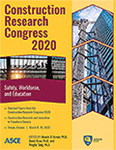Construction Research Congress 2020
Leveraging Accident Investigation Reports as Leading Indicators of Construction Safety Using Text Classification
Publication: Construction Research Congress 2020: Safety, Workforce, and Education
ABSTRACT
Despite containing a wealth of information pertaining to construction accidents, accident investigation reports have traditionally been used to understand the immediate cause of accidents and keep statistical records. Such analyses only provide insight into what has happened on-site and are classified as lagging indicators of safety. This study intends to explore the potential of using accident investigation reports as a predecessor to reveal latent factors that can potentially lead to an accident. In this regard, accident investigation reports were manually annotated to tag the type of injury precursor, energy source, accident type, and injury severity. By studying a large volume of accident reports, a more comprehensive knowledge of which conditions and factors have resulted in which type and severity of accidents were generated. This paper also presents a framework to automate such an analysis process by proposing an automated natural language processing-based method to distill crucial information from a tremendous amount of readily available accident reports. This study will help industry practitioners to discover hidden factors causing accidents and provide guidance to avoid accidents on site. This study will also assist safety managers to prioritize operations based on potential hazards and pay more attention to activities that seem harmless but have led to a significant loss in the past.
Get full access to this article
View all available purchase options and get full access to this chapter.
REFERENCE
Albert, A., and Hallowell, M. R. (2017). “Modeling the Role of Social Networks on Hazard Recognition and Communication.” Practice Periodical on Structural Design and Construction, 22(4), 04017016.
Albert, A., Hallowell, M. R., Skaggs, M., and Kleiner, B. (2017). “Empirical measurement and improvement of hazard recognition skill.” Safety Science, Elsevier Ltd, 93, 1–8.
Alruqi, W. M., and Hallowell, M. R. (2019). “Critical Success Factors for Construction Safety: Review and Meta-Analysis of Safety Leading Indicators.” Journal of Construction Engineering and Management, 145(3), 04019005.
Bureau of Labor Statistics. (2007). “Occupational Injury and Illness Classification Manual.” U.S. Department of Labor, (September), 1–353.
Bureau of Labor Statistics US Department of Labor. (2017). “National Census of Fatal Occupational Injuries in 2017.” Bureau of Labor Statistics US Department of Labor, (202), 1–14.
Friedman, L. S., and Forst, L. (2007). “The impact of OSHA recordkeeping regulation changes on occupational injury and illness trends in the US: A time-series analysis.” Occupational and Environmental Medicine, 64(7), 454–460.
Goh, Y. M., and Ubeynarayana, C. U. (2017). “Construction accident narrative classification: An evaluation of text mining techniques.” Accident Analysis and Prevention, Elsevier, 108(July), 122–130.
Kaggle Inc. (n.d.). “OSHA Accident and Injury Data | Kaggle.” <https://www.kaggle.com/ruqaiyaship/osha-accident-and-injury-data-1517/version/1> (Aug. 1, 2019).
Malcolm, X., Haley, A., and Autobiography, T. (2014). “2014 P.” (202), 5–7.
Pedregosa, F., Varoquaux, G., Gramfort, A., Michel, V., and Thirion, B. (2014). “Scikit-learn: Machine Learning in Python.” Thesis, 25(1), 1–64.
Prades, M. V. (2014). “Attribute-based Risk Model for Assessing Risk to Industrial Consturction Tasks.”
Tixier, A. J. P., Hallowell, M. R., Rajagopalan, B., and Bowman, D. (2016). “Automated content analysis for construction safety: A natural language processing system to extract precursors and outcomes from unstructured injury reports.” Automation in Construction, Elsevier B.V., 62(2016), 45–56.
Zhang, F., Fleyeh, H., Wang, X., and Lu, M. (2019). “Construction site accident analysis using text mining and natural language processing techniques.” Automation in Construction, Elsevier, 99(December 2018), 238–248.
Zhang, J., and El-Gohary, N. M. (2013). “Semantic NLP-Based Information Extraction from Construction Regulatory Documents for Automated Compliance Checking.” Journal of Computing in Civil Engineering, 30(2), 04015014.
Information & Authors
Information
Published In
Construction Research Congress 2020: Safety, Workforce, and Education
Pages: 490 - 498
Editors: Mounir El Asmar, Ph.D., Arizona State University, David Grau, Ph.D., Arizona State University, and Pingbo Tang, Ph.D., Arizona State University
ISBN (Online): 978-0-7844-8287-2
Copyright
© 2020 American Society of Civil Engineers.
History
Published online: Nov 9, 2020
Published in print: Nov 9, 2020
Authors
Metrics & Citations
Metrics
Citations
Download citation
If you have the appropriate software installed, you can download article citation data to the citation manager of your choice. Simply select your manager software from the list below and click Download.
